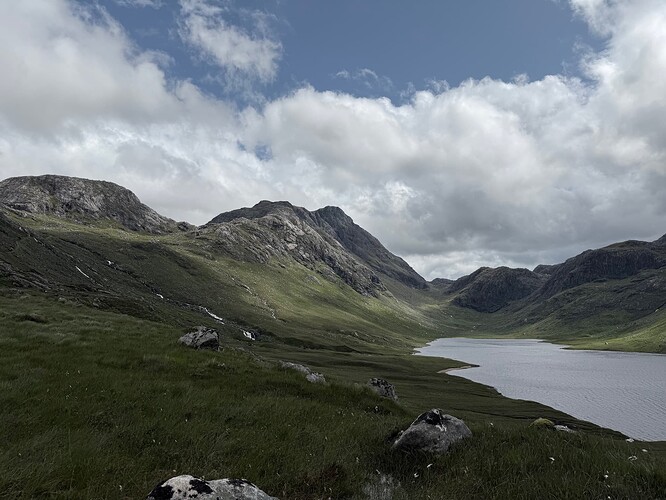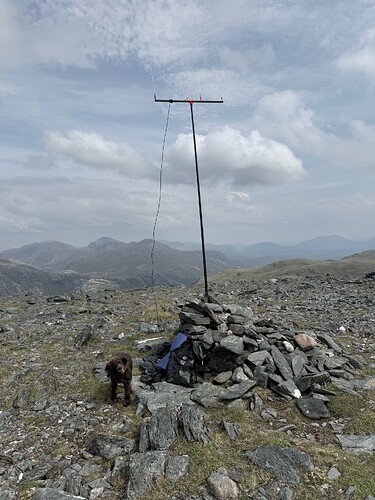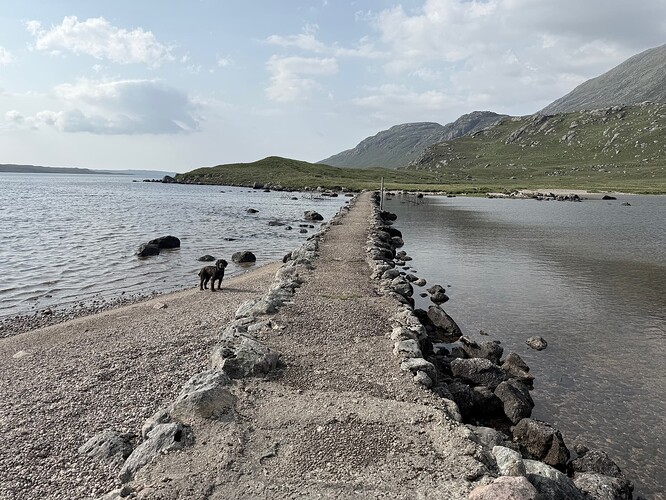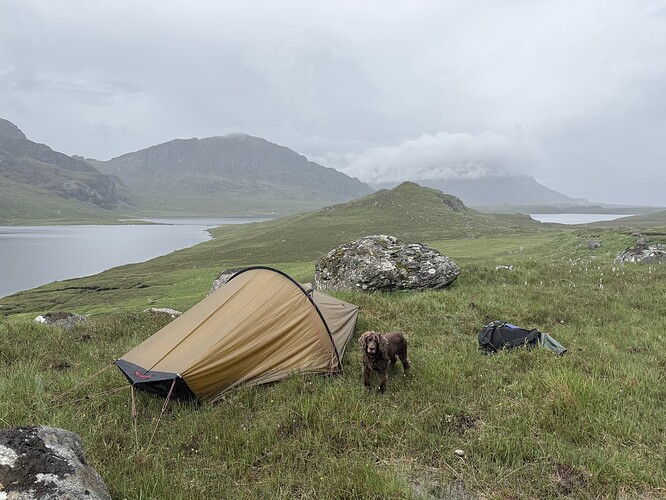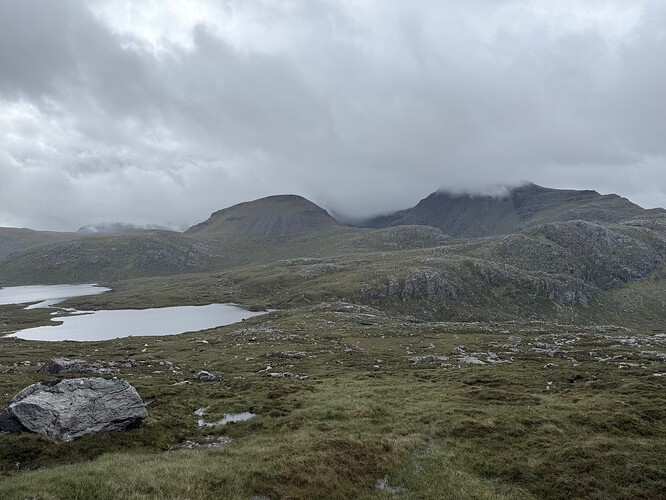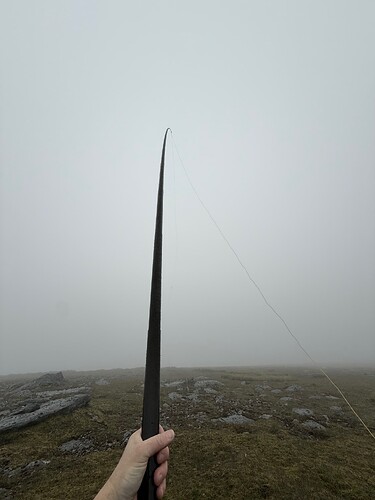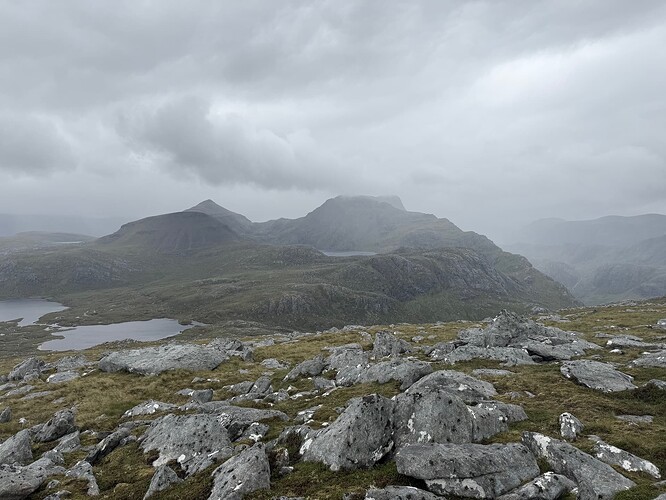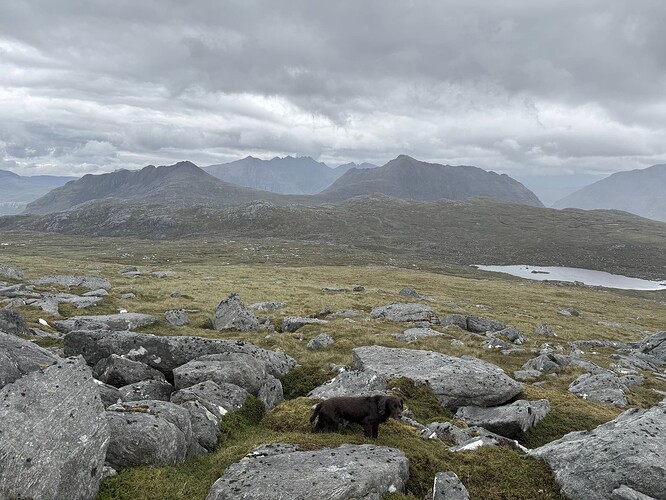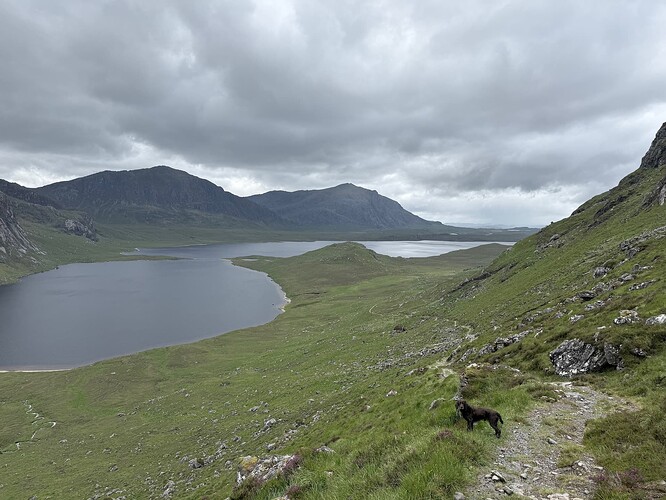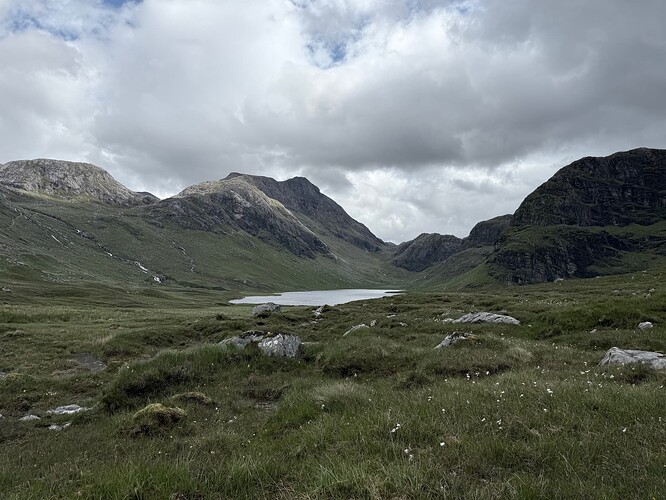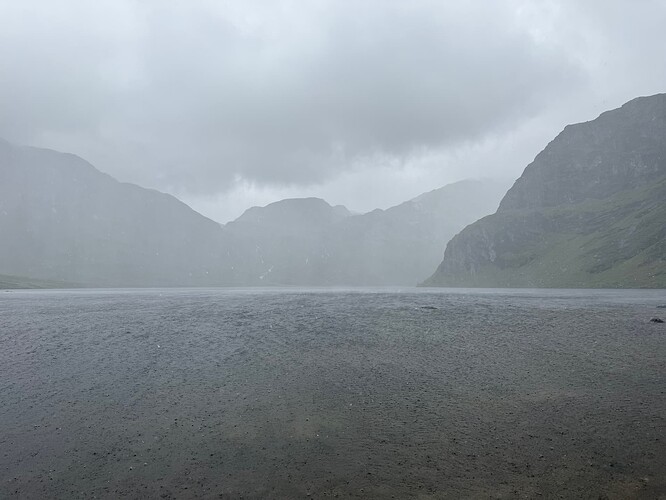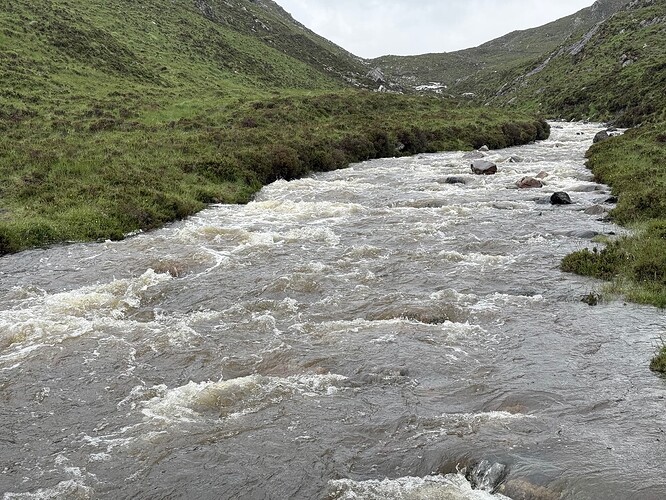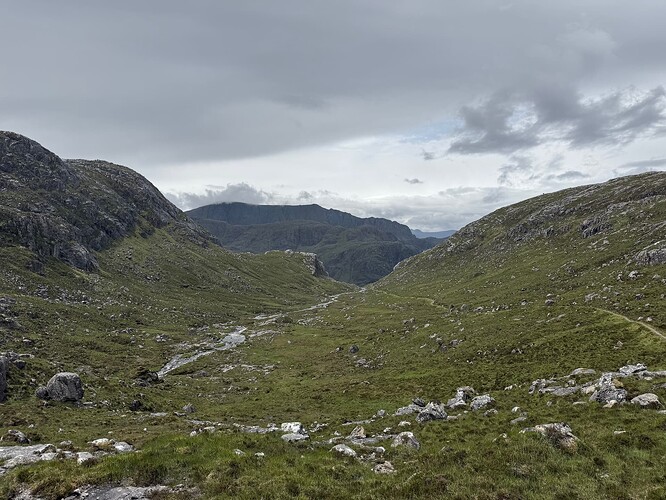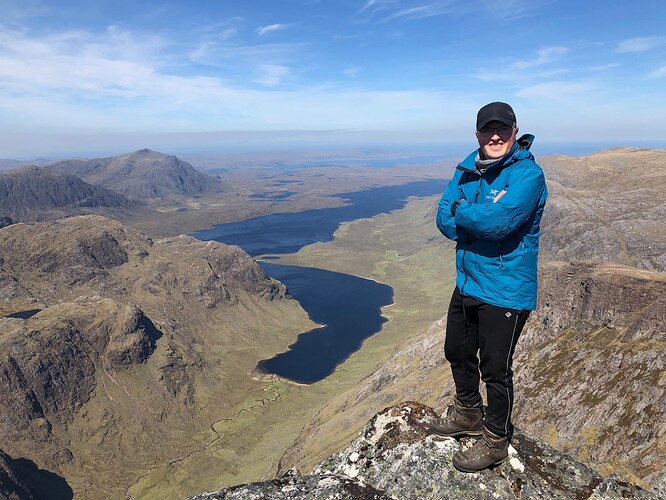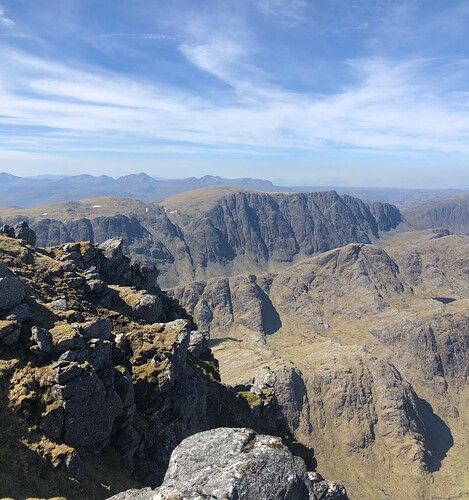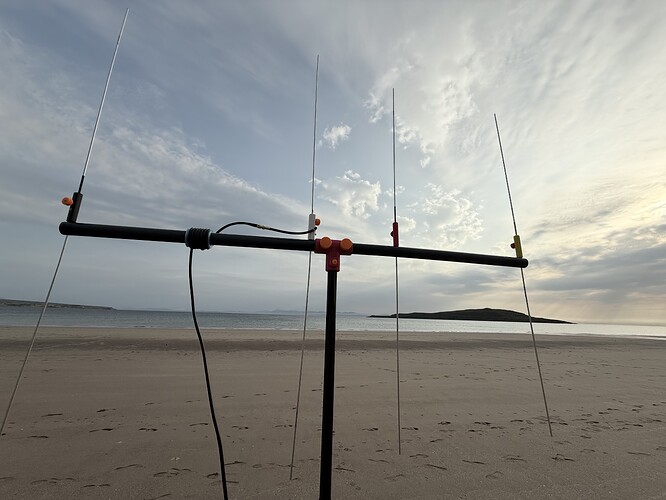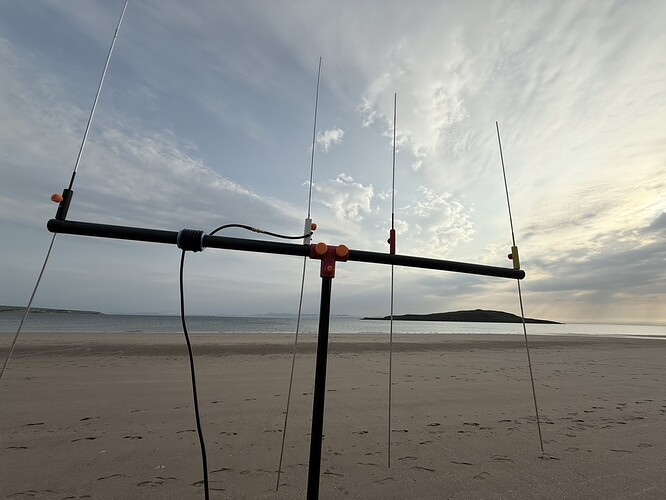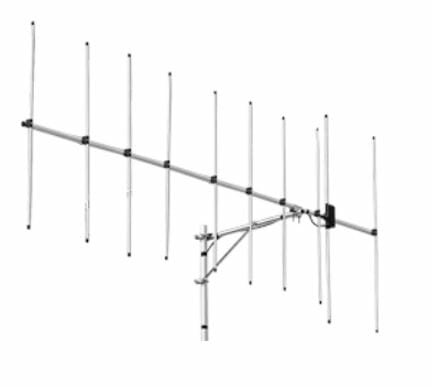A SOTA trip to some of the most remote mountains in the UK with river crossings, relentless rain and regrettable midge encounters.
A’Mhaighdean and Dubh Loch
Day 1 – The Big Walk In and Beinn Lair (GM/NS-027)
The trip began on a surprisingly hot and clear day, not what you’d expect on the west coast as i heading into one of the UK’s most remote areas. I cycled the first part of the route with Shadow (loyal companion and chief morale officer), who rode comfortably on my rucksack while my pack was carried on the panniers.
Shadow just Cruising
Progress was interrupted by a snakebite puncture, which delayed things while I carried out a repair. I haven’t had one of these in a long time, and forgot that they come in pairs - and only repaired one ![]() but we were soon moving again.
but we were soon moving again.
At the base of Beinn Lair (GM/NS-104), I stashed most of the overnight gear and began the ascent. It’s a fine Corbett, with a steep and dramatic northern face overlooking a hidden valley, Gleann Tulacha, an impressively remote summit that felt every bit the part.
Beinn Lair
At the summit, I quickly set up for VHF. This was the first real test of a new collapsible 2m Yagi that I’ve designed and 3D printed, with the aim of being lightweight and packable. It performed very well, enabling a solid 5W contact with GM4OAS in Mallaig that wouldn’t have been possible otherwise. I also had a good summit-to-summit QSO with @MM7MOX/P, who was activating GM/WS-178.
2m 3D printed collapsable Yagi in action.
HF conditions weren’t great, and I quickly gave up after only a few contacts. I didn’t hang around for too long the midges were out and so were the clegs.
Causeway across to Cairnmor
One summit down, plenty of midge bites banked already, and a forecast sent via Iridium from @MM0EFI suggested the good weather wasn’t going to last.
Evening – Carnmore
After the activation, I continued on to find a camping spot near Carnmore. I got set up and had some rehydrated slop for dinner. Conditions, however, were far from idea; too hot inside the tent, and not enough breeze to keep the midges at bay outside. After a frustrating spell trying to get comfortable, I decided to take a walk down to the bothy.
Camp
There, I was greeted by an unexpected but very welcome sight: a group of fishermen from Dundee who had been staying in the lodge all week while touring the lochs. I’d arrived just as they were working through the last of the week’s supplies; which included a generous amount of food on a fire and alcohol.
I was quickly invited in and couldn’t refuse the hospitality, nor could Shadow, who immediately made himself at home right infront of the BBQ. It turned into a brilliant evening of good food, conversation, and company in one of the most outstanding valleys in the UK. Sincere thanks to a great bunch of random fishermen from Dundee who turned what could have been a very uncomfortable night into one of the highlights of the trip.
Day 2 – Beinn a’Chaisgein Mòr (GM/NS-028)
The plan for the day was to activate two very remote peaks: Beinn a’Chaisgein Mòr (GM/NS-028), followed by A’ Mhaighdean (GM/NS-013), the most remote Munro in the UK.
*A’Mhaighdean and Ruadh Stac Mor in the clouds
I woke to the sound of heavy rain on the tent. MM7MOX had given me a heads-up the previous day via VHF about morning showers, and he was absolutely right. I decided to leave the tent in place at Carnmore and travel light to the summit of Beinn a’Chaisgein Mòr.
The weather on the approach and summit was very poor — constant, driving rain and strong winds. There’s no natural shelter on the summit, so I found a large rock and did my best to hunker behind it during the activation. It was one of the most difficult conditions I’ve ever operated in.
45 degree Pole deployment and a flapping wire
Hoping to qualify on 2m VHF, I only managed two contacts, so I set up HF. In the conditions, I had to compromise: the antenna was just a wire flapping in the wind, supported by a handheld mast at roughly 45 degrees. The antenna kept detuning in the gusts, but with some persistence, I managed to get a good few contacts through. Huge thanks to everyone who worked me: it made all the difference.
Descent and Return
After descending from Beinn a’Chaisgein Mòr, I made my way toward A’ Mhaighdean (GM/NS-013), but decided to call it. The weather was worsening, huge amounts of water were being unleashed at times, I was soaked, tired and not in the right headspace to push further. I turned back towards camp at Carnmore. On the descent, the views opened up to remind me how awesome this place is !
From there, I began the long 24 km journey back to the van. And as the day wore on, the rain became relentless.
Driving rain across Dubh Loch
River levels had risen significantly, and many of the smaller crossings were now in full spate. One river, in particular, was right at the edge of what I’d consider safe to cross. It took two crossings, one of which involved carrying Shadow in the rucksack.
River crossing - at the limit
Unfortunately, I lost my 2m collapsible Yagi during the crossing. Not the end of the world — I’ll just print another one !
A fantastic couple of days in this unique wilderness!
